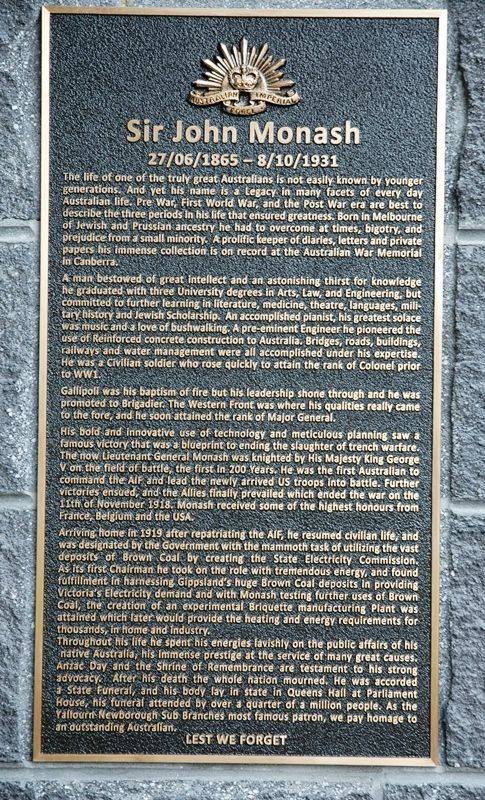
General Sir John MonashPrint Page 

A plaque commemorates soldier and public servant, Sir John Monash (1865-1931), who was born in West Melbourne in 1865. A gifted student, he embarked on a career in engineering and from 1887 was a part-time militia officer. On the outbreak of war Monash was appointed to command the 4th Infantry Brigade.
After the Gallipoli campaign he was promoted to command the new 3rd Australian Division, which took part in the fighting at Messines and the Passchendaele offensive in 1917. In early 1918 it faced the Germans on the Somme. Monash displayed great military skills, a powerful intellect and inspiring leadership qualities. He impressed his own soldiers and higher command. In June 1918 he was promoted to lieutenant-general and appointed to command the Australian Corps.
He led his Australians through a series of victorious actions until the end of the war. By the 1920s Monash was probably regarded as the greatest living Australian. Despite being an administrator and leader, rather than a fighting soldier, he had become integral to the ANZAC legend.
Location
| Address: | Boolarra Avenue, Newborough, 3825 |
|---|---|
| State: | VIC |
| Area: | AUS |
| GPS Coordinates: | Lat: -38.177811 Long: 146.299523 Note: GPS Coordinates are approximate. |
Details
| Monument Type: | Plaque |
|---|---|
| Monument Theme: | People |
| Sub-Theme: | Military |
| Actual Event Start Date: | |
| Actual Event End Date: |
Dedication
| Actual Monument Dedication Date: | Sunday 12th November, 1950 |
|---|
Sir John Monash
27 / 06 / 1865 - 8 / 10 / 1931
The life of one of the truly great Australians is not easily known by younger generations. And yet his name is a legacy with many facets of every day Australian life. Pre War, First World War, and the Post War era are best to describe the three periods in his life that ensured greatness. Born in Melbourne of Jewish and Prussian ancestry he had to overcome at times, bigotry, and prejudice from a small minority. A prolific keeper of diaries, letters and private papers his immense collection is on record at the Australian War Memorial in Canberra. A man bestowed with great intellect and an astonishing thirst for knowledge he graduated with three University degrees in Arts, Law and Engineering, but committed to further learning in literature, medicine, theatre, languages, military history and Jewish scholarship. An accomplished pianist, his greatest solace was music and a love of bushwalking. A pre-eminent engineer he pioneered the use of reinforced concrete construction to Australia. Bridges, roads, buildings, railways and water management were all accomplished under his expertise. He was a civilian soldier who rose quickly to attain the rank of Colonel prior to WW1.
Gallipoli was his baptism of fire but his leadership shone through and he was promoted to Brigadier. The Western Front was where his qualities really came to the fore, and he soon attained the rank of Major General. His bold and innovative use of technology and meticulous planning saw a famous victory that was a blueprint to ending the slaughter of trench warfare. The now Lieutenant-General Monash was knighted by His Majesty King George V on the field of battle, the first in 200 years. He was the first Australian to command the AIF and lead the newly arrived US troops into battle. Further victories ensued, and the Allies finally prevailed which ended the war of the 11th of November 1918. Monash received some of the highest honours from France, Belgium and the USA. Arriving home in 1919 after repatriating the AIF, he resumed civilian life, and was designated by the Government with the mammoth task of utilizing the vast deposits of brown coal by creating the State Electricity Commission.
As its first Chairman he took on the role with tremendous energy, and found fulfillment in harnessing Gippsland`s huge brown coal deposits in providing Victoria`s electricity demand and with Monash testing further used of brown coal, the creation of an experimental briquette manufacturing plant was attained which later would provide the heating and energy requiremnents for thousands, in homes and industry.
Throughout his life he spent his energies lavishly on public affairs of his native australia, his immense prestige at the service of many great causes. ANZAC Day and the Shrine of Remembrance are testament to his strong advocacy. After his death the whole nation mourned. He was accorded a state funeral, and his body lay in state in Queens Hall at Parliament House, his funeral attended by over a quarter a million people. As the Yallourn Newborough Sub Branches most famous patron, we pay homage to an outstanding Australia.
Lest We Forget



